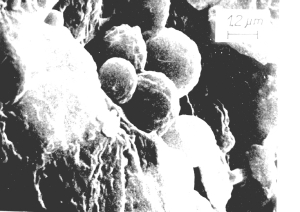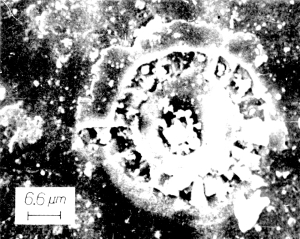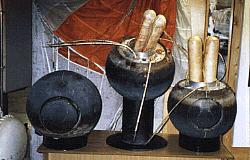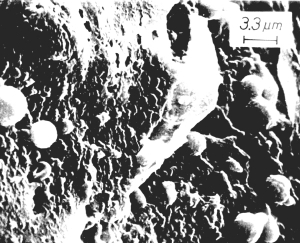Microorganisms from the Moon
|

|
Further study of the photographs was later undertaken by two biologists at the Russian Academy of Sciences, Stanislav I. Zhmur, Institute of the Lithosphere of Marginal Seas, and Lyudmila M. Gerasimenko, Institute of Biology. They noticed that a few of the particles in the photographs were virtually identical to fossils of known biological species. Specifically, some spherical particles from the Luna 20 regolith plainly resemble fossils of modern coccoidal bacteria like Siderococcus or Sulfolobus in their scale, distribution, form, and the distortion of the spheres that occurs during fossilization.
The Luna 16 regolith contained a fossil whose striking morphology was not overlooked by the editors of the 1979 atlas. Because of its concentric circular form with strong spokes, they guessed it was a tiny meteorite crater. But Zhmur and Gerasimenko saw the fossil's unmistakable resemblance to modern spiral filamentous microorganisms like Phormidium frigidum, found in growing stromatolites in Shark Bay, Australia, and to spiral filamentous microorganisms from early Proterozoic shiungites of Karelia. Their new analysis of these particles was announced at an astrobiology conference in Denver, 20-22 July 1999, and published in the conference proceedings in December 1999 (4).
 Luna 16: A silicated fossil found in lunar regolith similar to modern spiral filamentous microorganisms such as Phormidium frigidum. View larger image and microscopic impact craters for comparison. |
The microfossils from the moon are different. Each Luna sample was encapsulated on the moon and opened only in a laboratory where examination commenced immediately. These fossils are solid evidence for ancient life elsewhere in space.
 Luna 16, 20, 24: Sample return capsules on display at the NPO Lavochkin Museum. |
What'sNEW since 2000
References
1. Luna 16, NASA Goddard Space Flight Center.2. Luna 20 / Drill, by David R. Williams, NASA Goddard Space Flight Center.
3. O.D. Rode, A.V. Ivanov, M.A. Nazarov, A. Cimbalnikova, K. Jurek and V. Hejl. Atlas of Photomicrographs of the Surface Structures of Lunar Regolith Particles, Boston: D. Reidel Publishing Co., 1979.
4. Stanislav I. Zhmur and Lyudmila M. Gerasimenko. "Biomorphic forms in carbonaceous meteorite Alliende and possible ecological system - producer of organic matter chondrites" [abstract] in Instruments, Methods and Missions for Astrobiology II, Richard B. Hoover, Editor, Proceedings of SPIE Vol. 3755 p. 48-58 (1999).
5. Fossilized Bacteria in Murchison and Efremovka, a CA webpage, posted 27 January 2000.
6. 31st Lunar and Planetary Science Conference, JSC, NASA, 13-17 March 2000.
